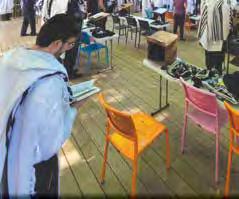
8 minute read
100 Y ears; 1,000s Daily by Ariel Vale




100 Years




1,000S




DAILY BY ARIEL VALE
Life
for a Shabbos-observing Jew in the early 20 th century was not easy in America. Friday after Friday, men would be fired from their jobs. It took a courageous group of men to make the move upstate where it would be easier to find an occupation that would not interfere with their values. In the summer of 1920, the Woodbourne Shul was founded.
The shul was not just a place where people came to daven. It was an active center for an active Jewish community. What better place to hold a slaughterhouse for kosher meat than the back room of the shul?
The years passed with much victory and advancement for the Shabbos Jew. The city boasted large communities with many job opportunities. Slowly, the children of so many ended up moving back, seeking their fortune there. Across America, hundreds of shuls were forced to close their doors, boarding them up or selling them to others. The glorious Woodbourne Shul did not escape that fate. At the turn of the millennia, eighty years after opening, saturated with thousands of teffilos and

dozens of bar mitzvah celebrations, the shul had no choice but to close its beautiful doors forever. The board members were adamant that a holy edifice as such should not be sold or defiled. For ten long years, the shul sat boarded up in silence, waiting.
There was an elderly woman, well into her eighties, devotedly caring for the kever of the Menuchas Asher, Rav Asher Anshil, of blessed memory. When asked what prompted this, she replied: “When I was in my forties, the doctors had already given up on my life. I prostrated myself on the kever and tear
fully davened. Ever since then, I devotedly maintain the upkeep of this special tzaddik’s resting place.”
The legacy of this miracle worker continued when his son replanted his father’s community in Crown Heights. The kehilla was of great acclaim and merited an annual visit from the Satmar Rav, Rav Yoel. It was in this setting that the next generation, Rav Mordechai Zev Jungreis, Nikolsburger Rebbe, was born.
Every alumnus of Yeshivas Rabbeinu Chaim Berlin will remember his year with Rabbi Jungreis with ease. Giving and loving are the two traits that are oft repeated when describing that unusual time. Just recently, a talmid brought his grandson to the Rebbe for an upsherin, a sure example of the type of bond that is formed between rebbi and talmid.
But there’s more. A young married man with a few children of his own revealed something fascinating. When he was a young boy in Yeshivas Chaim Berlin, he was known as a troublemaker. Rebbi upon rebbi would send him out of class to wander the halls. However, every boy knew “that if you get kicked out, you go to Rabbi Jungreis’ class.” The man attributed his success in staying frum and bringing up a family to that safe haven where everyone was unequivocally loved and accepted for who he is. Where others struggled in the area of chinuch, the Rebbe thrived and achieved. It is with this background that we begin to understand the miracle that occurred. The Rebbe heard the silent plea of that forlorn building standing erect on Main Street and decided that the time had come to reinstate it. The building that had served its members faithfully for eighty years and lay dormant for ten was about to fulfill a role not unlike its original one.
There were Jews, tens of thousands of them, making the trip up to the Catskills to vacation. Camps and bungalow colonies were bursting at the seams, and it seemed that there was a lot more freedom, and loneliness, for children at risk. They were there, roaming the streets; hollow, sad eyes, but who even noticed them? Did anyone even care?
The Rebbe cared. The Rebbe’s heart was open for them.
But here’s the secret.
The Rebbe loves them because he loves everyone. Be he a fellow Rebbe, Litvishe Rosh Yeshiva, at-risk teen, or anyone in between, you are a diamond in the eyes of this defending angel.
So he worked hard. He bargained, cajoled, and begged the skeptical board members to reopen.
“There is a need, it’s time, and we’re ready,” he claimed, but there was a lot of red tape, ill feelings, and disbelief to work through.
He got the call while sitting in Chaim Berlin


with his precious talmidim.
“Are you still interested?” they wanted to know.
“I’m driving right up!” he exclaimed as he jumped into his car for the long trip.
There were a lot of conditions and obstacles, but soon enough, they were in business. The Rebbe got to work ceremoniously placing a cardboard box in front of the shul proclaiming: “Minyan Mincha.” Passing cars rolled down their windows, unabashedly sharing their opinion: “vus machstu meshuga?” [Why are you making yourself crazy?] they wondered. “Nothing will come of it.”
But the Rebbe pulled through, and the shul would open after one more necessary step.
The Rebbe ran to a printing store and ordered a large laminated sign. With this, the shul was fully operational. The sign read: “EVERYONE IS WELCOME.” Only with this can the doors open.
With the purchase of the building, the expenses started mounting. Electricity, water, refreshments, as the crowd quickly grew. To everyone’s disbelief, over 1,000 people entered through those doors in 2010, the first year they were reopened. By 2011, there were 10,000.
Today, there are thousands entering daily. Just count the used cups.
“Why is the Rebbe’s gartel wet?” people wanted to know. Come on over at 5:30 in the morning, you’ll see the Rebbe, rag in hand, wiping down each outside table in the aftermath of a downpour. There’s a full day of learning and davening ahead.
Shacharis starts at 6:05 a.m. When’s the next minyan? “As soon as there’s a minyan!” says the Rebbe. Come in at any given time, and you are likely to see six minyanim in full swing.
See only five? That means you’re a tzenter!
Don’t be fooled if you’re told that Nikolsburg closes at two in the morning. That’s just the inside. Outside, the minyanim are in full swing. The three hours of closure are very important for a Rebbe who never leaves his post during opening hours. He makes sure to use some of the time for sleeping. Don’t see the Rebbe? He must have gone to the bakery to buy more cake. Maybe he’s running low on lollipops for the children. There is no Nikolsburger gabbai. The Rebbe trusts nobody with this holy task.
“Why don’t you lie down for a few minutes?” urges his son.
“I rest in the car on the way to the bakery,” responds the Rebbe. “That’s when I get to sit down.”
Soon enough, the building got too crowded. It was time to extend.
“If there’s room in the heart, there’s room in the building,” he proclaimed after being offered money for renovations. Last year, the Rebbe acquiesced to building a deck behind the shul. Nobody was quite sure what changed. Then the world turned upside down. Will there be a shul this year? What about the people who don’t want to daven inside? The new deck held all the answers. Those concerned about Corona can stay outside. Those with antibodies come right in. While the Rebbe himself is always makpid to wear a mask, the open-door policy will remain regardless. The sign on the door urges all entering to follow suit; nobody is turned away.
“We must listen to the government and make a Kiddush Hashem,” the Rebbe says.
There is one thing that is never tolerated in Nikolsburg. One thing so appalling that even the Rebbe cannot bear. Machlokes is unwelcome here. Just look around the shul. It’s self-explanatory; only harmony.
Take a look at the Rebbe’s shtender. There are lists of names. People come for tefillos and brachos from this humble man. After all, he is a Rebbe.
Recently, a boy was lost in the forest. Bochurim came down to speak to the Rebbe. “Go back to camp and tell everyone to calm down,” he said with a forcefulness those closest to him didn’t know he possessed. “Tell everyone that he will be found.”
Sounds typical of a Rebbe. Now let me tell you about atypical miracles.
Every amud has a chiyuv. Would these people have been able to get one every day in a typical shul? Many admit that they would’ve missed davening with a minyan if not for this shul. Forgot your tefilin? Maybe you just never had any? Help yourself to a pair from the gemach. Don’t be shy. Nobody’s looking at you. Looking to make up a few missed minyanim? Just walk around the shul and stock up on kaddish.
This is the legacy passed down in the Jungreis family. Miracle workers. The minyan is culled together from Kew Garden Hills to Satmar. Nobody stares at you. Nobody cares what you’re wearing. All are loved and accepted.
Miracles!
Do you have another way to describe a day in Nikolsburg?










